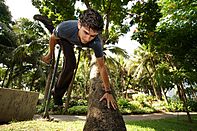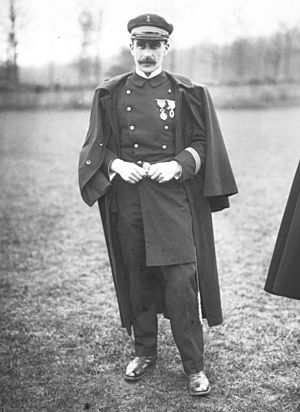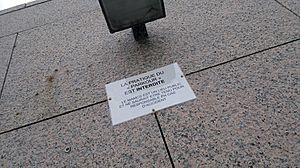Parkour facts for kids

An athlete performing parkour
|
|
| Also known as | PK |
|---|---|
| Focus | Obstacle passing |
| Country of origin | France |
| Creator | David Belle Yamakasi |
| Ancestor arts |
|
| Descendant arts | Freerunning |
| Olympic sport | Not currently; IOC discussions underway |
Parkour is an exciting activity. It combines running, jumping, climbing, and rolling. It's a smooth and creative way to move through your surroundings. It's not just about getting from one place to another fast. It's about overcoming obstacles with skill and style.
Think of it as a fun way to explore your environment. You can turn everyday objects into exciting challenges! Parkour can be done alone or with friends. While you can do it anywhere, it's often practiced in cities.
Parkour started in France and is now popular worldwide. Many countries have groups of people who practice it. Social media has also helped parkour grow. Lots of videos show amazing moves, inspiring many to try it. Now, there are parkour schools and gyms everywhere. They offer training for all ages and skill levels.
Contents
What is Parkour?
The name "parkour" comes from the French word "parcours." This word means "course" or "path." It shows that parkour is about finding a way through your environment. You creatively move around obstacles and challenges.
Early parkour practitioners were called "traceurs." This comes from the French word "tracer," meaning "to trace." They saw the city as a giant playground. It was full of chances for movement and exploration.
History of Parkour
Similar ways of moving have existed for centuries. Many communities around the world had these athletic traditions. For example, some indigenous tribes in Africa practiced similar skills. In Chinese culture, there is qinggong. This is a Chinese martial arts training technique. It also dates back hundreds of years.
A person who helped create parkour in Western Europe was Georges Hébert. He was a French naval officer. Before World War I, he promoted athletic skills. He based them on the tribes he met in Africa. Hébert taught physical education in France. He created a "méthode naturelle" (natural method). This method had ten basic groups of movement. These included walking, running, jumping, and climbing.
During World War I and World War II, this teaching grew. It became the standard for French military training. Inspired by Hébert, a Swiss architect created a "parcours du combattant." This was a military obstacle course. Today, such courses are standard in military training.
The modern form of parkour began in France. It was developed in the late 1980s and early 1990s. David Belle and his father, Raymond Belle, created it. Raymond Belle was a firefighter. He loved physical fitness. He made a training method that focused on overcoming obstacles. He used natural movements. His son, David, added his own creative style. This led to a unique way of moving.
The Belle family and their friends practiced in Lisses, France. They used the city's buildings, walls, and other structures. This early practice focused on natural movement and being efficient. They wanted to overcome obstacles in the best and smoothest way. They aimed to be graceful and precise, not just fast.
Key Principles of Parkour
Parkour follows several important ideas:
- Efficiency: Traceurs try to move with the least energy. They choose the best moves for each situation.
- Precision: Being accurate is very important. Traceurs must land exactly on their target. This needs careful planning and action.
- Fluidity: Parkour movements should flow smoothly together. This creates a continuous series of actions. It takes practice and good coordination.
- Creativity: Parkour encourages new ideas and adapting. Traceurs change their moves for different places and challenges. There are many ways to get past an obstacle.
- Confidence: Overcoming fears and building self-belief is a big part of parkour. Traceurs learn to trust their skills. They push themselves beyond what feels easy. This happens slowly with regular practice.
- Respect: Respect for the environment and for yourself is key. Traceurs must always think about safety. They avoid damaging property or hurting themselves or others. Always ask for permission before practicing on private land.
Main Parkour Movements
Parkour uses many different movements, such as:
- Parkour roll: Rolling to soften landings from high jumps. You roll diagonally over a shoulder to change downward force into forward motion.
- Precision jump: Jumping and landing accurately with both feet. This is used for small or narrow obstacles.
- Arm jump: Jumping and landing feet-first on a vertical surface. You then grab the top with your hands.
- Wall run: Running towards a tall wall. Then, you jump and push off the wall with one foot to reach the top.
- Climb up: Moving from hanging onto a wall or ledge to standing on top. Or, you can vault over to the other side.
Training and Progress
Parkour training is a gradual process. Beginners start with simple moves. These include running, jumping, and rolling. They slowly learn more advanced techniques. It's important to start slowly. Focus on doing the movements correctly to avoid injuries. Many parkour groups and gyms offer training programs. These programs are for all skill levels. They often include warm-ups, drills, and harder obstacles over time.
Safety First
Safety is very important in parkour. Traceurs should always:
- Warm up properly: This helps prevent injuries.
- Start slowly: Gradually make things harder. This lets your body get used to the activity.
- Use correct technique: Good form lowers the risk of getting hurt.
- Practice with a partner: Having someone watch can help prevent accidents.
- Choose safe places: Do not practice in dangerous areas.
- Wear the right clothes and shoes: This helps protect your body.
- Listen to your body: If you feel pain, stop and rest.
Parkour Organizations
There are international parkour groups. One is the World Freerunning and Parkour Federation. It was started in 2007. They have worked with MTV on parkour shows.
The International Gymnastics Federation (FIG) added parkour in 2017. The first FIG Parkour World Cup event was in April 2018. Parkour also appeared at the 2022 World Games.
Parkour in Popular Culture
Parkour has become popular in movies, video games, and TV shows.
In 2006, the James Bond film Casino Royale showed parkour. Sébastien Foucan was in a chase scene. This brought new attention to parkour. Along with The Bourne Ultimatum (2007), Casino Royale helped start a new trend. Many Western films and TV shows began using parkour stunts. Parkour was also seen in Live Free or Die Hard (2007) and Prince of Persia: The Sands of Time (2010).
MTV's show Ultimate Parkour Challenge started in 2009. It featured athletes from the World Freerunning & Parkour Federation.
Many modern video games now include parkour. It is often a main part of how you play the game.
Images for kids
See also
 In Spanish: Parkour para niños
In Spanish: Parkour para niños






